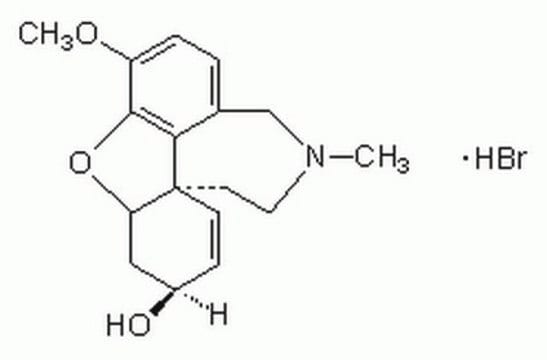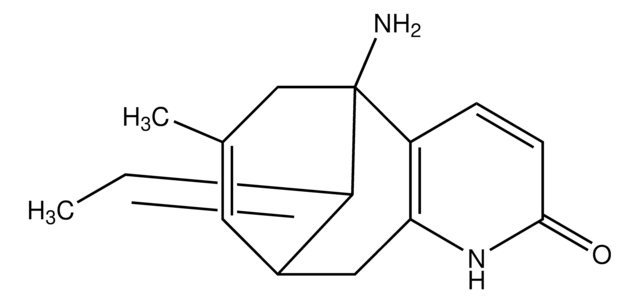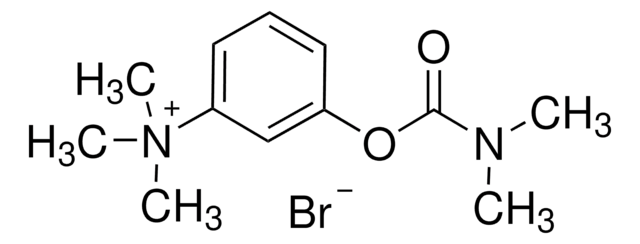G1660
Galanthamine hydrobromide from Lycoris sp.
≥94% (HPLC)
Sinonimo/i:
Galantamine hydrobromide
About This Item
Prodotti consigliati
Origine biologica
plant (Ungeria victoris)
Saggio
≥94% (HPLC)
Forma fisica
powder
Punto di fusione
270 °C
Solubilità
DMSO: soluble 10 mg/mL, clear, colorless
water: soluble 20 mg/mL, clear, colorless
Temperatura di conservazione
−20°C
Stringa SMILE
Br[H].COc1ccc2CN(C)CC[C@@]34C=C[C@H](O)C[C@@H]3Oc1c24
InChI
1S/C17H21NO3.BrH/c1-18-8-7-17-6-5-12(19)9-14(17)21-16-13(20-2)4-3-11(10-18)15(16)17;/h3-6,12,14,19H,7-10H2,1-2H3;1H/t12-,14-,17-;/m0./s1
QORVDGQLPPAFRS-XPSHAMGMSA-N
Informazioni sul gene
human ... ACHE(43)
Cerchi prodotti simili? Visita Guida al confronto tra prodotti
Descrizione generale
Applicazioni
- as an AChE (acetylcholinesterase) inhibitor and positive control in acetylcholinesterase assay performed to determine the activity of AChE
- as a positive control in the screening of AChE inhibitors
- as a positive control in AChE inhibitory assay performed to determine the AChE-inhibitory activities of pyrithione and related sulfur-containing pyridine N-oxides
Azioni biochim/fisiol
Confezionamento
Avvertenze
Danger
Indicazioni di pericolo
Consigli di prudenza
Classi di pericolo
Acute Tox. 3 Oral
Codice della classe di stoccaggio
6.1C - Combustible acute toxic Cat.3 / toxic compounds or compounds which causing chronic effects
Classe di pericolosità dell'acqua (WGK)
WGK 3
Punto d’infiammabilità (°F)
Not applicable
Punto d’infiammabilità (°C)
Not applicable
Dispositivi di protezione individuale
Eyeshields, Faceshields, Gloves, type P2 (EN 143) respirator cartridges
Certificati d'analisi (COA)
Cerca il Certificati d'analisi (COA) digitando il numero di lotto/batch corrispondente. I numeri di lotto o di batch sono stampati sull'etichetta dei prodotti dopo la parola ‘Lotto’ o ‘Batch’.
Possiedi già questo prodotto?
I documenti relativi ai prodotti acquistati recentemente sono disponibili nell’Archivio dei documenti.
I clienti hanno visto anche
Il team dei nostri ricercatori vanta grande esperienza in tutte le aree della ricerca quali Life Science, scienza dei materiali, sintesi chimica, cromatografia, discipline analitiche, ecc..
Contatta l'Assistenza Tecnica.









